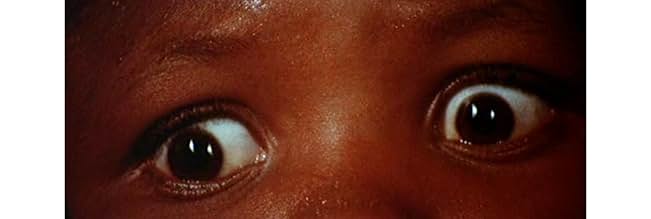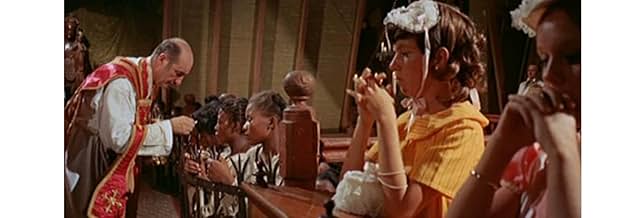IMDb रेटिंग
6.5/10
2 हज़ार
आपकी रेटिंग
अपनी भाषा में प्लॉट जोड़ेंTwo documentary filmmakers go back in time to the pre-Civil War American South to film the slave trade.Two documentary filmmakers go back in time to the pre-Civil War American South to film the slave trade.Two documentary filmmakers go back in time to the pre-Civil War American South to film the slave trade.
- निर्देशक
- लेखक
- स्टार
Stefano Sibaldi
- Narrator
- (वॉइस)
Dick Gregory
- Self
- (बिना क्रेडिट के)
Gualtiero Jacopetti
- Self
- (बिना क्रेडिट के)
Ernest Kubler
- Whip
- (बिना क्रेडिट के)
Yayoi Kusama
- Self
- (बिना क्रेडिट के)
Franco Prosperi
- Self
- (बिना क्रेडिट के)
Shelley Spurlock
- Girl
- (बिना क्रेडिट के)
फ़ीचर्ड समीक्षाएं
Addio Zio Tom: 7/10: Well they don't make them like this anymore and lets face it they never really did. This is really three separate films brought together in a blender set on random. The first film is a highly effective expose on slave treatment and the slave trade in the old south (the slave ship scenes blows Hollywood fare like Armistad out of the water). Using a cast of thousands and exposing practices such as selective breeding that are politely not discussed on American shores (just ask Jimmy the Greek) it simply is one of the most realistic display's of 18th and 19th century slave life ever shown on film.
Then there is a second film which is a dated, and looking back rather silly collection, of news footage from the late sixties and early seventies that documents race riots with all the participants speaking in Italian creating an almost Woody Allen feel to the dub (It gives What's up Tiger Lilly a run for its money complete with ragtime music cementing the silliness of what should be serious proceedings.)
The last movie is a sexploitation film dealing largely with Mandingo fantasies and containing a copious amount of child porn. (I guess National Geographic rules apply when showing thirteen year old black children naked). Needless to say tasteful does not enter into the conversation. Political correctness is shattered so badly one must feel for those sensitive souls that can't laugh at ridiculousness of the manipulation.
Making matters worse the three films are intertwined together seemingly at random with comic buffoonery breaking out during serious scenes (A slave auction is apt to turn into a Benny Hill episode for no apparent reason) and poorly done black revenge fantasies coming, narratively at least, out of nowhere. Anti-white, anti-black and for the sake of inclusion anti-Semitic they once again simply don't make them like this anymore. (It's highly illegal for one thing)
Overlong by at least an hour and very poorly thought out in places Addio Zio Tom wears out its welcome but for a short while at least it exposes the truth and makes one think.
Then there is a second film which is a dated, and looking back rather silly collection, of news footage from the late sixties and early seventies that documents race riots with all the participants speaking in Italian creating an almost Woody Allen feel to the dub (It gives What's up Tiger Lilly a run for its money complete with ragtime music cementing the silliness of what should be serious proceedings.)
The last movie is a sexploitation film dealing largely with Mandingo fantasies and containing a copious amount of child porn. (I guess National Geographic rules apply when showing thirteen year old black children naked). Needless to say tasteful does not enter into the conversation. Political correctness is shattered so badly one must feel for those sensitive souls that can't laugh at ridiculousness of the manipulation.
Making matters worse the three films are intertwined together seemingly at random with comic buffoonery breaking out during serious scenes (A slave auction is apt to turn into a Benny Hill episode for no apparent reason) and poorly done black revenge fantasies coming, narratively at least, out of nowhere. Anti-white, anti-black and for the sake of inclusion anti-Semitic they once again simply don't make them like this anymore. (It's highly illegal for one thing)
Overlong by at least an hour and very poorly thought out in places Addio Zio Tom wears out its welcome but for a short while at least it exposes the truth and makes one think.
MONDO CANE and AFRICA ADDIO creators Gualtiero Jacopetti and Franco E. Prosperi take us on a journey through time, back to the mid 1800's, not too long before the civil war. The movie is styled like one of their previous documentaries, with actors talking to the camera as though being interviewed, and just about every form of human cruelty being enacted on the Africans who have been dragged overseas to become slaves.
The movie is certainly disturbing, and it did indeed enrage me that ancestors of mine took part in this treatment of fellow human beings. But the movie lost me whenever it tried to create a parallel between the climate between blacks and whites in the 1800s and the 1960s.
Not that there weren't (and, unfortunately, still are) problems with racial tension in this country, but the movie seems to think that the average black person is still a savage at heart, just waiting for the right moment to break out an axe and slaughter the first white person he comes across. The movie climaxes with a radical black man reading The Diary of Nat Turner and imagining doing just that, including a horrific moment in which he smashes a baby's head against the wall.
To me, the movie seems to have a negative opinion of just about everyone. Obviously, due to its decidedly anti-slavery stance, the slave traders are viewed as sick, inhuman monsters with only the faintest mask of civility on the surface. But the African characters are portrayed largely as ignorant buffoons, too dim-witted to understand what's happening to them.
Later, during the modern day scenes, the sole black character is shown as having a major chip on his shoulder that has driven him nearly insane with rage, while the white people are a bunch of care-free bubble heads. Such generalizations and lack of depth or character development greatly lessens the power the movie may have had.
But, as a purely gut-busting exercise in sleaze and disgusting imagery, GOODBYE UNCLE TOM sits confidently alongside other such gross-out movies as CANNIBAL HOLOCAUST, SALO and MEN BEHIND THE SUN. Also, like those movies, GUT (hmmm, interesting abbreviation) goes so outrageously over-the-top in depicting its atrocities, most of the movie's true power is lost, and it becomes little more than a freak show.
I hesitantly recommend the movie for fans of sick cinema as a curiosity. I warn pretty much everyone else to stay far, far away.
The movie is certainly disturbing, and it did indeed enrage me that ancestors of mine took part in this treatment of fellow human beings. But the movie lost me whenever it tried to create a parallel between the climate between blacks and whites in the 1800s and the 1960s.
Not that there weren't (and, unfortunately, still are) problems with racial tension in this country, but the movie seems to think that the average black person is still a savage at heart, just waiting for the right moment to break out an axe and slaughter the first white person he comes across. The movie climaxes with a radical black man reading The Diary of Nat Turner and imagining doing just that, including a horrific moment in which he smashes a baby's head against the wall.
To me, the movie seems to have a negative opinion of just about everyone. Obviously, due to its decidedly anti-slavery stance, the slave traders are viewed as sick, inhuman monsters with only the faintest mask of civility on the surface. But the African characters are portrayed largely as ignorant buffoons, too dim-witted to understand what's happening to them.
Later, during the modern day scenes, the sole black character is shown as having a major chip on his shoulder that has driven him nearly insane with rage, while the white people are a bunch of care-free bubble heads. Such generalizations and lack of depth or character development greatly lessens the power the movie may have had.
But, as a purely gut-busting exercise in sleaze and disgusting imagery, GOODBYE UNCLE TOM sits confidently alongside other such gross-out movies as CANNIBAL HOLOCAUST, SALO and MEN BEHIND THE SUN. Also, like those movies, GUT (hmmm, interesting abbreviation) goes so outrageously over-the-top in depicting its atrocities, most of the movie's true power is lost, and it becomes little more than a freak show.
I hesitantly recommend the movie for fans of sick cinema as a curiosity. I warn pretty much everyone else to stay far, far away.
Many people who have claimed to see this film have not. Most of those who have seen it, have not understood. GOODBYE UNCLE TOM was directed by Gualtiero Jacopetti & Franco E. Prosperi, the two men who pioneered the documentary movement that came to be known as the "Mondo" film, a term the two dislike immensely. Hot on the heels of their controversial and still-relevant AFRICA ADDIO, it was meant to exonerate them from accusations of racism. Ironically, it would do the exact opposite. It was developed as an idea to adapt the novel "Mandingo" as an historical, documentary style drama. What emerged was a shocking, difficult-to-watch-at-times, treatise on the horrors of slavery, and the source of racism in America, if not the world, today. It was the filmmakers' intention not to pander to a politically correct theory that slaves of the 1840's had a 1970's awareness of their situation. The events are all historically correct. Many of the characters are people who actually lived. The dialogue is verbatim from true manuscripts of the day. The racism is a genuine depiction of plantation life of the day. It was felt that glossing over the African experience in America would be an insult to the pain and suffering of the millions who survived the "middle passage' only to welcome a life a slavery, no different from an animal or piece of property.
Years after it's initial release, the directors have expressed a regret at not opening the film with an explanation stating that this was a film about the emotions of that bygone era, not of the filmmakers themselves.
The controversial final scenes, which take place in contemporary America, are based on "The Confessions of Nat Turner", and are meant to represent an angry, reactionary vengeance on behalf of the millions, with whom the character identifies. Malice for sure, but not unmerited malice. This film should cause strong emotions. Any film that tackles a moral issue must cause debate and conjecture if it is to succeed. What makes the film even more extraordinary is that it succeeds without claiming a moral superiority, or taking a moral stance. What appears on screen are the most graphic, realistic depictions of the North American slave trade of the 19th century, and this film should be required viewing in Black History classes on college campuses, and high schools all over the world, particularly in America. This film preceded ROOTS by six years and stands as a much harsher indictment of the evils of human bondage. This is one of the bravest works of cinema and remains a misunderstood humanitarian masterpiece.
Years after it's initial release, the directors have expressed a regret at not opening the film with an explanation stating that this was a film about the emotions of that bygone era, not of the filmmakers themselves.
The controversial final scenes, which take place in contemporary America, are based on "The Confessions of Nat Turner", and are meant to represent an angry, reactionary vengeance on behalf of the millions, with whom the character identifies. Malice for sure, but not unmerited malice. This film should cause strong emotions. Any film that tackles a moral issue must cause debate and conjecture if it is to succeed. What makes the film even more extraordinary is that it succeeds without claiming a moral superiority, or taking a moral stance. What appears on screen are the most graphic, realistic depictions of the North American slave trade of the 19th century, and this film should be required viewing in Black History classes on college campuses, and high schools all over the world, particularly in America. This film preceded ROOTS by six years and stands as a much harsher indictment of the evils of human bondage. This is one of the bravest works of cinema and remains a misunderstood humanitarian masterpiece.
I've seen a lot of offensive films in my time, from Cannibal Holocaust to A Siberian Film, but this one is easily the most tasteless, offensive, unpleasant films I have ever seen. Yet somehow it is also riveting, like watching a car crash unfold in slow motion. Several times I was on the verge of turning it off in sheer disgust, but found myself holding off, just to see how much more depraved it could get.
The "plot", such as it is, concerns a pair of time-travelling reporters from Italy going back to the south of the USA during the heyday of slavery, to conduct a "inquest" into slavery. Presenting itself as a condemnation of slavery, it instead revels in the unpleasantness, delivering atrocity upon atrocity with a smirk on it's face. The horror inflicted on the slaves in Django Unchained pales in comparison to the never-ending parade of unpleasantries served up here. I suppose it does present a view of what slaves went through at the time, but it's hard to feel that they are condemning the acts when all the slaves are presented as little more than dumb animals.
Amongst the dubious "delights" on offer are rape, castration, paedophilia and the truly horrible scene where the poor reporter is "seduced" by a 13 year old black prostitute. It's made so much worse as everything is presented as though we are seeing it through their eyes.
It's certainly unforgettable, and if you're not easily offended or squeamish, it's worth watching once, even if it's just to see how low Italian exploitation cinema managed to stoop. You might need a good shower afterwards, however.
Rating: 7/10 just for the sheer gall of the film.
The "plot", such as it is, concerns a pair of time-travelling reporters from Italy going back to the south of the USA during the heyday of slavery, to conduct a "inquest" into slavery. Presenting itself as a condemnation of slavery, it instead revels in the unpleasantness, delivering atrocity upon atrocity with a smirk on it's face. The horror inflicted on the slaves in Django Unchained pales in comparison to the never-ending parade of unpleasantries served up here. I suppose it does present a view of what slaves went through at the time, but it's hard to feel that they are condemning the acts when all the slaves are presented as little more than dumb animals.
Amongst the dubious "delights" on offer are rape, castration, paedophilia and the truly horrible scene where the poor reporter is "seduced" by a 13 year old black prostitute. It's made so much worse as everything is presented as though we are seeing it through their eyes.
It's certainly unforgettable, and if you're not easily offended or squeamish, it's worth watching once, even if it's just to see how low Italian exploitation cinema managed to stoop. You might need a good shower afterwards, however.
Rating: 7/10 just for the sheer gall of the film.
Not exactly a "humanitarian masterpiece" as someone else said (yeah right!). More like cryptic super-exploitation. This is wildly, hilariously, rollickingly misguided pseudo-history at best. Outright race-baiting at worst. Made by the sleazoids who barfed up "Africa Addios" (giving Africans their own country back so soon just wasn't the right idea, was it!!), a film that featured the genuinely bizarre white South African girls on trampolines montage. A fervent call-to-arms for African-Americans made by white Europeans must inherently ring false, I am afraid. (we enslaved you. kill us!) Manages to be both numbing and completely, hideously insulting at the same time.
The film is, under its very "SO racist it isn't being racist" exterior a sly work of racism. Presents blacks as nothing more than animals and savages, capable only of violence or submission to the will of whites. All the while remaining mute and mindless. No African-American in the film is presented as having a personality, substance, or intelligence. Every white all but glows. Every caucasian is a verbose, mercurial, immaculate sprite.
That said, the film does (I would assume) approximate the way Africans were treated during the slave era more closely than other films. In that respect it deserves respect. The conditions are shown as filthy, disgusting, cruel. Every imaginable indignity is portrayed (and some you probably could not imagine).
However, the film does have some power. The camera work is very inventive and the directors handle some of the chaotic scenes around the plantation very well. Some of the imagery is genuinely striking. There's a general feeling of chaos that comes through that's very effective. I'm not sure what the point is. But it's effective.
Anyway, see the movie if you really want to be grossed out and insulted. File this one under SUPER exploitation. The directors may have had good intentions when they started out, but I think they just lost it when they got onto the set and decided to see how far out they could go. And no one, it seemed, was around to tell them to tone it down or put on the breaks. This is up there with Cannibal Holocaust and Men Behind the Sun. It's that sort of a deal.
But don't kid yourselves, this AIN'T no humanitarian masterpiece.
The film is, under its very "SO racist it isn't being racist" exterior a sly work of racism. Presents blacks as nothing more than animals and savages, capable only of violence or submission to the will of whites. All the while remaining mute and mindless. No African-American in the film is presented as having a personality, substance, or intelligence. Every white all but glows. Every caucasian is a verbose, mercurial, immaculate sprite.
That said, the film does (I would assume) approximate the way Africans were treated during the slave era more closely than other films. In that respect it deserves respect. The conditions are shown as filthy, disgusting, cruel. Every imaginable indignity is portrayed (and some you probably could not imagine).
However, the film does have some power. The camera work is very inventive and the directors handle some of the chaotic scenes around the plantation very well. Some of the imagery is genuinely striking. There's a general feeling of chaos that comes through that's very effective. I'm not sure what the point is. But it's effective.
Anyway, see the movie if you really want to be grossed out and insulted. File this one under SUPER exploitation. The directors may have had good intentions when they started out, but I think they just lost it when they got onto the set and decided to see how far out they could go. And no one, it seemed, was around to tell them to tone it down or put on the breaks. This is up there with Cannibal Holocaust and Men Behind the Sun. It's that sort of a deal.
But don't kid yourselves, this AIN'T no humanitarian masterpiece.
क्या आपको पता है
- ट्रिवियाThe movie was originally released in Italy in a 119-minute version and immediately withdrawn when the directors were sued for plagiarism by writer Joseph Chamberlain Furnas. It was re-released in March 1972 in a re-cut 136-minute version under the title 'Zio Tom.'
- क्रेज़ी क्रेडिट'Questo film è un documentario. I fatti sono storicamente avvenuti ed i personaggi sono realmente esistiti.' Which translates to: 'This film is a documentary. The facts historically happened and the persons really existed.'
- इसके अलावा अन्य वर्जनBefore receiving a UK cinema certificate in 1973 the film was extensively cut by around 30 minutes by the BBFC with heavy edits to rape scenes, footage of sexual experiments, graphic violence, the fantasy murder sequence, and the opening scenes on the slave ship.
- कनेक्शनFeatured in Adam & Yves (1974)
टॉप पसंद
रेटिंग देने के लिए साइन-इन करें और वैयक्तिकृत सुझावों के लिए वॉचलिस्ट करें
- How long is Goodbye Uncle Tom?Alexa द्वारा संचालित
विवरण
- रिलीज़ की तारीख़
- कंट्री ऑफ़ ओरिजिन
- भाषाएं
- इस रूप में भी जाना जाता है
- Addio Zio Tom
- फ़िल्माने की जगहें
- Port-au-Prince, Haiti(Majority of interiors and exteriors)
- उत्पादन कंपनी
- IMDbPro पर और कंपनी क्रेडिट देखें
इस पेज में योगदान दें
किसी बदलाव का सुझाव दें या अनुपलब्ध कॉन्टेंट जोड़ें























